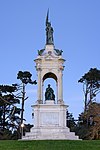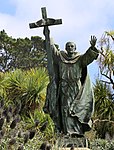California Academy of Sciences
1853 establishments in California2000s architecture in the United StatesAssociation of Science-Technology Centers member institutionsBuildings and structures burned in the 1906 San Francisco earthquakeBuildings and structures completed in 2008 ... and 14 more
California Academy of SciencesExpressionist architectureFuturist architectureGolden Gate ParkInstitutions accredited by the American Alliance of MuseumsMuseums in San FranciscoNatural history museums in CaliforniaOrganizations established in 1853Ove Arup buildings and structuresPlanetaria in the United StatesPostmodern architecture in CaliforniaRenzo Piano buildingsScience and technology in the San Francisco Bay AreaScience museums in California

The California Academy of Sciences is a research institute and natural history museum in San Francisco, California, that is among the largest museums of natural history in the world, housing over 46 million specimens. The Academy began in 1853 as a learned society and still carries out a large amount of original research. The institution is located at the Golden Gate Park in San Francisco. Completely rebuilt in 2008, the Academy's primary building in Golden Gate Park covers 400,000 square feet (37,000 m2). In early 2020, before the COVID-19 pandemic, the California Academy of Sciences had around 500 employees and an annual revenue of about $33 million.
Excerpt from the Wikipedia article California Academy of Sciences (License: CC BY-SA 3.0, Authors, Images).California Academy of Sciences
Music Concourse Drive, San Francisco
Geographical coordinates (GPS) Address Website External links Nearby Places Show on map
Geographical coordinates (GPS)
| Latitude | Longitude |
|---|---|
| N 37.7701 ° | E -122.466407 ° |
Address
California Academy of Sciences
Music Concourse Drive 55
94118 San Francisco
California, United States
Open on Google Maps











